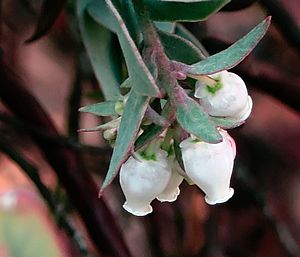Santa Lucia manzanita facts for kids
Quick facts for kids Santa Lucia manzanita |
|
|---|---|
 |
|
| Conservation status | |
| Scientific classification |
Arctostaphylos luciana, also known as the Santa Lucia manzanita, is a special kind of manzanita plant. It grows only in California, which means it is endemic to that state.
Where It Lives
This woody plant is found only in the southern part of the Santa Lucia Mountains. This area is located in San Luis Obispo County.
It likes to grow in places called coastal sage scrub and chaparral habitats. These are areas with many shrubs and dry conditions. You can often find it on rocky slopes made of shale. It grows at elevations from about 330 feet to 2,600 feet (100 to 800 meters). It prefers slopes that face the ocean, especially where the cool, moist air from the sea, called the marine layer, reaches.
What It Looks Like
The Santa Lucia manzanita is a shrub or a small tree. It often has several trunks. It usually grows to be about 6 to 10 feet (2 to 3 meters) tall.
Leaves, Flowers, and Fruit
Its leaves are a grayish-blue color, which is called glaucous. They can feel waxy or woolly, or sometimes they are smooth. The edges of the leaves are smooth. The leaves are rounded or oval shaped. They are about 0.6 to 1 inch (1.5 to 2.5 cm) wide and 0.8 to 1.6 inches (2 to 4 cm) long. The base of the leaf sometimes looks like it has a small lobe.
The plant's inflorescence is a group of flowers that grow together. These flowers are pink and white. They are smooth and shaped like an urn, which is like a small pot. The flowers hang downwards. This manzanita blooms, or flowers, from February to March.
After the flowers, the plant produces fruit. The fruit is a red or reddish-green drupe. A drupe is a fleshy fruit with a hard pit inside, like a cherry. These fruits can be up to about 0.5 inches (1.2 cm) wide.
Protecting This Plant
The Santa Lucia manzanita is considered a special plant that needs protection. The California Native Plant Society keeps a list of rare and endangered plants. This species is on that list. It is seen as a fairly endangered and vulnerable species. This means it could be at risk of disappearing if we don't protect it.
Some groups of these plants are safe inside the Los Padres National Forest. They are in a special area called the southern Cuesta Ridge Botanical Special Interest Area. This helps to make sure they can continue to grow and thrive.


